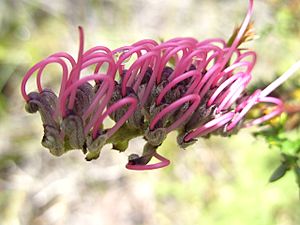Acanthus-leaved grevillea facts for kids
Quick facts for kids Acanthus-leaved grevillea |
|
|---|---|
 |
|
| Grevillea acanthifolia flowers near Blackheath | |
| Scientific classification | |
| Genus: |
Grevillea
|
| Species: |
acanthifolia
|
Grevillea acanthifolia, also known as the Acanthus-leaved grevillea, is a special plant. It belongs to the plant family called Proteaceae. This plant is found only in New South Wales, Australia. It's a type of shrub with stiff, spiky leaves and pretty pink to purple flowers that look like a "toothbrush."
Contents
What Does It Look Like?
Grevillea acanthifolia is a shrub that can grow upright or spread out. It usually reaches about 0.5 meters (1.6 feet) tall. Sometimes, it can grow up to 3 meters (10 feet) tall and 4 meters (13 feet) wide.
Its leaves are quite unique. They are bright green, stiff, and feel prickly. Each leaf has 9 to 14 main parts, called lobes. These lobes are 4 to 9 centimeters (1.6 to 3.5 inches) long and 3 to 7 centimeters (1.2 to 2.8 inches) wide. Each lobe might even be divided further, ending in a sharp tip.
The flowers grow in groups that look like a "toothbrush" on one side. These flower groups are 3 to 10 centimeters (1.2 to 3.9 inches) long. The tiny outer parts of the flower, called sepals and petals, are pale green to grey. They are hairy on the outside and smooth on the inside. The long, red part of the flower, called the style, is 20 to 28 millimeters (0.8 to 1.1 inches) long. It has a green tip called a pollen presenter.
You can see this plant flowering all year round. However, it blooms most often from October to February. After the flowers, it produces a hairy fruit called a follicle with reddish marks.
How It Got Its Name
The plant Grevillea acanthifolia was first officially described in 1825. A botanist named Allan Cunningham discovered it. He found it during an expedition in 1817. Cunningham saw the plant growing in wet, boggy areas on the Blue Mountains and near Cox's River.
The second part of its name, acanthifolia, tells us something about its leaves. It comes from the plant Acanthus and the Latin word folium, which means "a leaf." This name was chosen because the leaves of Grevillea acanthifolia look similar to those of the Acanthus plant.
There are three main types, or subspecies, of Grevillea acanthifolia:
- Grevillea acanthifolia subsp. acanthifolia: This type has egg-shaped or wedge-shaped leaf lobes. It grows in swampy places or on wet rocks in the Blue Mountains.
- Grevillea acanthifolia subsp. paludosa: This one is also known as the bog grevillea. It's an upright shrub that can grow up to 3 meters (10 feet) tall. Its leaf lobes are narrow and may have some hairs underneath. You can find it in swamps and by streams at high altitudes, inland from Bega.
- Grevillea acanthifolia subsp. stenomera: This subspecies usually grows less than 1 meter (3.3 feet) tall. Its leaf lobes are narrow and smooth. It grows on the Northern Tablelands and higher parts of the North Coast.
There is also a special plant called Grevillea × gaudichaudii. This plant is a "hybrid," which means it's a mix of G. acanthifolia and another plant called Grevillea laurifolia.
Where It Grows
This grevillea plant only grows in New South Wales, Australia. It prefers higher areas and wet or boggy places.
Protecting This Plant
Some types of Grevillea acanthifolia need protection.
- Subspecies stenomera is considered "rare." It grows in many places, but its populations are small. Some of these plants are in protected areas, so they are not currently in danger.
- Subspecies paludosa is listed as "Endangered." This means it is at a high risk of disappearing forever. It is protected under the NSW Threatened Species Conservation Act and the Australian Government's Environment Protection and Biodiversity Conservation Act 1999 (EPBC) Act. The biggest dangers to its survival are losing its natural home, changes in how rivers flow, and being stepped on or eaten by farm animals.
Growing It in Gardens
Some people grow subspecies acanthifolia in their gardens. However, it can be a bit tricky to grow in lower areas. It grows best in a sunny spot and can handle cold weather and heavy frosts.
Images for kids
See also
 In Spanish: Grevillea acanthifolia para niños
In Spanish: Grevillea acanthifolia para niños



